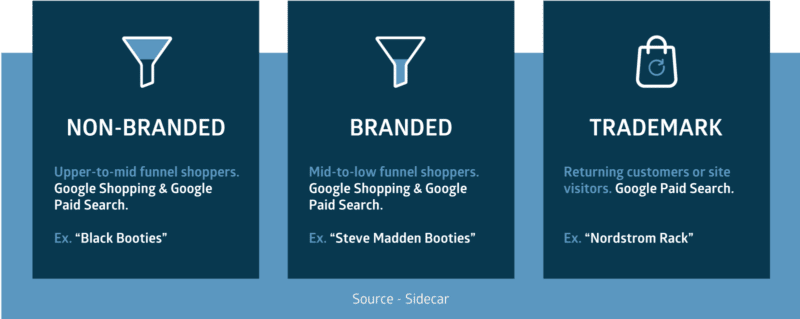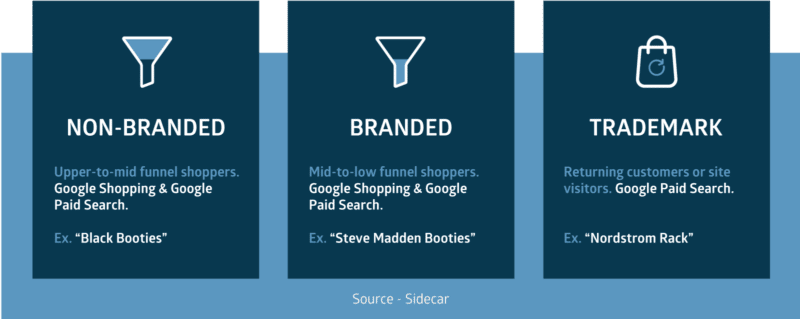When it comes to Google Ads, most retail marketers are interested in a single KPI – return on ad spend. To increase ROAS, some marketers devote the majority of their ad spend to high-converting, branded traffic. While a focus on efficiency still serves retail marketers well today, it’s more difficult to improve ROAS than ever. That is because investing primarily in low-funnel, branded traffic limits reach to the shoppers who already know your brand. This customer pool is both finite and shrinking.
Google Ads is also saturated with competition and constantly changing. Players including Amazon and Walmart are buying up the SERP and often outbid other retailers on their most lucrative keywords and products. Dwindling real estate for organic ads creates additional pressure to spend more to remain competitive.
To combat these challenges, retail marketers must adopt a more holistic approach to Google Ads. It’s important to understand how to acquire new customers and continue to retain existing ones by targeting diverse traffic types.
In this article, we’ll outline how reevaluating your keyword traffic can help you achieve unique goals for your business, including new customer acquisition and retention. Read on for tactics to keep costs in check and maximize the value of your trademark, branded, and non-branded campaigns on Google Ads.
An integrated view of Google Ads traffic
First, understanding the full customer journey on Google Ads means understanding the unique value of different keyword traffic. Naturally, keywords indicate purchase intent—which is why it’s important to create campaigns that target branded, non-branded, and trademark keywords, and to bid each keyword type according to its value for your business.
While there are exceptions, low-funnel shoppers tend to search using branded keywords. They know what type of product they want and are closer to making a purchase. Upper funnel shoppers tend to use generic, non-branded keywords because they are still researching what they’d like to buy. Shoppers who use trademark keywords are often returning customers.

Depending on your goals, these different traffic types may be more or less important for your business. Let’s unpack that idea.
Non-branded traffic drives acquisition
Many retail marketers have struggled to unlock the potential of non-branded traffic. When evaluated by ROAS, non-branded campaigns on paid search seem to underperform. Especially when viewed with a last click attribution model, these campaigns can appear unprofitable. Unsurprisingly, many retailers have overlooked this traffic type and focused more resources on low-funnel shoppers who are more likely to convert. However, it’s time to flip that notion on its head. Here’s how.
Understand the value of a new customer
With increased competition and costs, retailers must consider the value of the shopper they are reaching on Google Ads. For some retailers, a new customer will have a higher value than a returning customer because of his potential for repeat purchases, also known as customer lifetime value (CLV). If your business prioritizes new customer acquisition, the higher cost of non-branded traffic may be justified.
Limit costs with a targeted strategy
Keep efficiency in mind when developing non-branded campaigns. Bid first on keywords related to your highest margin or CLV products. It is unlikely that you will be able to bid on a large amount of non-branded keywords, so picking the right keywords and products is critical. Support those ads with compelling copy and landing pages that help shoppers make an informed decision. They may not be ready to land on a product page, but instead want to view a page that lists multiple products within a category or explains product features.
Track the full customer journey
Retargeting shoppers who visit your site from a generic query can increase the value of non-branded traffic. A shopper may discover your site through a non-branded keyword search. You can retarget that shopper when she searches again using a branded keyword and drive the final conversion. Tracking this type of customer journey and giving appropriate value to each click requires a multi-touch attribution model. You may not be able to understand the true value of non-branded click without a full view of the acquisition funnel.
Trademark improves retention
Trademark queries can also be easy to overlook. Some retailers assume that if shoppers are searching for their trademark keywords, those shoppers will eventually end up on their site. In today’s hyper-competitive SERP, that is not a given. Thanks to Google’s 2013 SERP update, competitors are increasingly bidding on trademark terms in Google Ads. While they cannot use your trademark keyword in their ad copy, they can undercut your business by offering discounts or faster delivery to effectively steal your customers. Here are some ways to work around this challenge.
Protect your trademark terms
Owning your trademark search can make the difference between retaining and losing a customer. The good news is that it’s easy to own your trademark terms. Your trademark ad will have a high-quality score compared to your competitors’ ads because you are the actual retailer the shopper is searching for. Make sure your ad showcases the product categories and unique services you offer. Utilize ad extensions to capture as much of the SERP as possible.
Measure your Google Ads health
Monitor trademark campaign performance carefully. Trademark traffic is a helpful barometer for overall Google Ads health. If you face increased competition or new customer acquisition slows, you may see a gradual decline in trademark traffic. Your business is no longer the first option that comes to mind for shoppers in your vertical. If that is the case, it’s time to rethink your Google Ads strategy and identify where the gaps are in your customer acquisition funnel.
Understand the full customer journey
Branded traffic may still account for the majority of your sales on Google Ads, but it’s important to have dedicated trademark and non-branded campaigns if only to understand how shoppers discover and rediscover your products. Having that understanding will put you in a much better position when an e-commerce giant like Amazon begins bidding on your most valuable branded keywords. If you cannot compete for clicks immediately before purchase, you need to step back and view the full customer journey to uncover new opportunities for growth. Crafting targeted campaigns for branded, non-branded, and trademark keywords will help you engage shoppers at every stage of the shopping journey and uncover new value.
The post Competition forces retailers to rethink the role of branded, non-branded and trademark traffic appeared first on Search Engine Land.
Source: IAB

